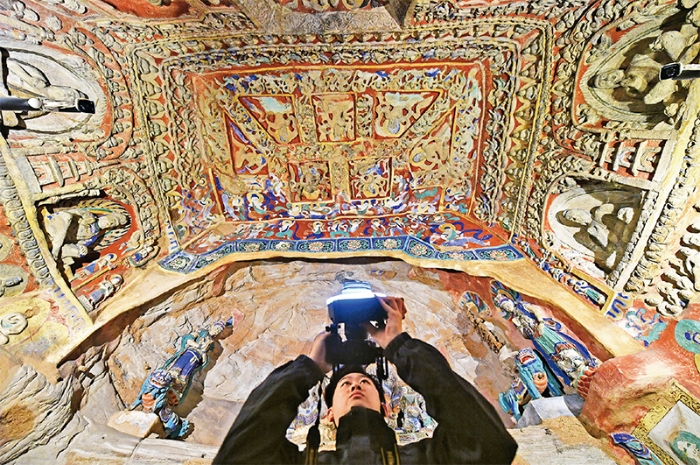The Ancient Yungang Grottoes Are Alive with Vitality
2022-07-14 10:44:30 | Author:Wu Xiaodi and Duan Lijun | Source:en.qstheory.cn2022-07-12
Located at the southern foot of the Wuzhou Mountain in Datong, Shanxi Province, the Yungang Grottoes are among the largest Buddhist grotto temples in China. The grandeur, exquisite artistry, and unique charm of the grottoes are a major draw for visitors from far and wide. On May 11, 2020, President Xi Jinping made a visit to the grottoes to inspect historical and cultural heritage protection at the site. President Xi stressed, "The Yungang Grottoes are a world cultural heritage site. Their protection matters for not only China but the world." In the spirit of this statement, protection at the Yungang Grottoes has been continuously strengthened; the site's cultural resources have been further harnessed, and studies of the Yungang Grottoes have become lively. As the ancient grottoes have been infused with vitality, a magnificent historical and cultural corridor has also begun to take shape and extend outward from the site.
Creating a grand vision for Yungang
The Yungang Grottoes were carved more than 1,500 years ago. Housing over 59,000 Buddhist statues of distinct designs, they form a cultural treasure house of ancient Buddhist and stone carving art, fusing elements of Chinese and foreign culture, ethnic minority culture, and Central Plains culture. In recent years, protection and utilization at the site have been set on a course of accelerated progress. Development of the large scenic area has proceeded at full tilt, and the local store of rich cultural heritage has been fully brought into play. "On my last visit here, I toured the site in less than forty minutes," said one visitor to the grottoes. "This time around, I have explored the new museum and art exhibition and attended music, dance, and shadow puppetry performances. Even if I spent the full day here, I'm not sure I could see everything."
To pursue more holistic and multifaceted development, the Yungang Scenic Area has just finished crafting a new vision for its future. Officially approved at the start of this year, the Tourism Plan for the Yungang Historical and Cultural Corridor envisages a future in which the Yungang Grottoes sit at the heart of a historical and cultural corridor with an area of about 120 square kilometers. In the medium to long term, this corridor will form part of a larger cultural tourism belt spanning roughly 250 kilometers along ancient China's frontier to also incorporate the Xikou culture of Youyu County and the Wang Zhaojun culture of Inner Mongolia. At this point, Yungang's much-anticipated grand vision will have become a reality.
Attaching digital wings to cultural relics
In the exhibition hall of the Digital Protection Center of Yungang Research Institute (YRI), visitors wearing virtual reality headsets immerse themselves in lifelike scenes of Yungang caves and statues. According to the staff, the virtual reality system can support up to 15 users at any one time. At exhibitions and other events in cities like Fuzhou and Luoyang and in countries including France, Japan, and the US, the system has enabled people to digitally enjoy the wonders of grottoes.
With the aim of digitally preserving and showcasing cultural relics, technicians have undertaken projects to develop digital models and 3D replicas of typical grottoes at Yungang and to digitally compile statue fragments. Director of the Digital Protection Center at YRI, Ning Bo explained, "Using multi-part 3D printing and block assembly, we created a life-size replica of a Yungang cave, making this the first time such a large cultural relic has been duplicated anywhere in the world. This achievement has allowed Yungang to take solid steps toward the rest of China and the wider world."
The use of digital technology to preserve cultural relics has also enabled the ancient cultural site of Yungang to go online and take its place in the cloud. In the digital age, immovable cave art has been brought to life and introduced to the world in the most youthful of ways.

A staff member collects image data at the Wuhua Caves, May 8, 2021. In recent years, the cultural protection team of Yungang Research Institute has relied on technology to gather information on grotto structures and colors and build a "digital archive" of the Yungang Grottoes. PHOTO BY XINHUA REPORTER ZHAN YAN
Developing Yungang studies
In an effort to promote Yungang studies and carry forward Yungang culture, several specialized research institutions, including the YRI, have been established in succession and have produced a string of research outcomes. Research has focused on representative cultural heritage including the Yungang Grottoes, to trace the development of its historical lineage via in-depth discussions on the inheritance and evolution of social culture.
In 2019, the 20-volume Complete Works of the Yungang Grottoes
was published after a compilation process that lasted seven years. This
collection has created a huge digital database of grotto images. By
facilitating future research and inspiring a large number of new
academic views, this collection will serve as a precious resource for
people wanting to familiarize themselves with, understand, and study
Yungang. A series of other academic works, such as the Report on the Excavation of Caves at the Top of the Yungang Grottoes Site,
have been compiled and published, with studies focusing mainly on the
fields of ethnology during the Northern Wei Dynasty and cultural and
ethnic integration along the Silk Road. "Yungang studies" is also
gaining in international popularity, as China enjoys deeper cultural
exchanges with countries along the Silk Road.
(Originally appeared in Qiushi Journal, Chinese edition, No. 9, 2022)
Source: English Edition of Qiushi Journal,No. 3, 2022
